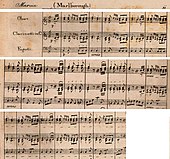Wellington's victory
Wellington's Victory or the Battle of Vittoria op. 91 is an orchestral work by Ludwig van Beethoven .
history
Ludwig van Beethoven composed the symphonic battle painting on the occasion of the Battle of Vitoria (Beethoven writes: Vittoria ), which took place on June 21, 1813 near Vitoria-Gasteiz in the Basque Country and in which the British and French faced each other.
Beethoven received the inspiration for the composition from Johann Nepomuk Mälzel , who was looking for an effective piece of music for his mechanical panharmonicon , with which he wanted to tour the European capitals. After Beethoven had finished the composition in October 1813, Mälzel came up with the further suggestion that the work should also be arranged for a large orchestra . With a few concerts in this form, money should be collected for the planned tour, because Mälzel's financial resources were exhausted.
The work was enthusiastically received by the audience, unlike many of Beethoven's symphonies or instrumental concerts . The world premiere on December 8, 1813 in Vienna was a spectacle in which all of Vienna's great composers took part: Antonio Salieri was one of the two conductors, Giacomo Meyerbeer and Ignaz Moscheles played in the huge orchestra, which was supported by numerous drums. Beethoven had the overall musical direction.
The piece begins with drum rolls and then works through the British patriotic song Rule, Britannia! and the French folk song Malbrough s'en va-t-en guerre . At the end the British national anthem God Save the King can be heard - Great Britain triumphs over Napoleon . The piece was so successful that it had to be repeated several times after the world premiere.
Outline of the work
First division: battle
- Drums and trumpets on the English side
- Marcia: Rule Britania
- Drums and trumpets on the French side
- Marcia: Marlborough
- Trumpet on the French side: request
- Trumpet on the English side: countercall
- Battle. Allegro
- Storm March. Allegro assai
Second section: Victory Symphony
- Intrada: Allegro ma non troppo
- Allegro con brio
- Andante grazioso
- Tempo I
- Tempo di minuetto moderato
- Allegro
literature
- Annemarie Firme, Ramona Hocker (Ed.): Of battle hymns and protest songs. On the cultural history of the relationship between music and war . Transkript Verlag, Bielefeld 2006, ISBN 3-89942-561-8 .
- Sebastian Hansen: Sounds of the Battle. Napoleon, his wars and music . In: Sabine Mecking, Yvonne Wasserloos (eds.): Music, power, state: cultural, social and political change processes in the modern age . V & R Unipress, Göttingen 2012, ISBN 978-3-89971-872-0 , pp. 22-98, in particular pp. 78 ff.
- Wulf Konold: Classical concert guide: Orchestral music from AZ. Atlantis / Schott, Zurich / Mainz 1997 (1987), ISBN 3-254-08224-9 .
- Helmut Loos: Beethoven between Vienna and Berlin . In: Julia Bungardt, Maria Helfgott, Eike Rathgeber, Nikolaus Urbanek (eds.): Viennese music history: approaches - analyzes - prospects; Festschrift for Hartmut Krones . Böhlau, Vienna 2009, ISBN 978-3-205-78389-3 , pp. 195-212.
- Nicholas Mathew: History under Erasure: "Wellingtons Sieg", the Congress of Vienna, and the Ruination of Beethoven's Heroic Style . In: The Musical Quarterly. 89, No. 1 (Spring, 2006), pp. 17-61 ( JSTOR 25172830 ).
- Nicholas Mathew: Political Beethoven . Cambridge University Press, 2013, ISBN 978-1-107-00589-1 .
Web links
- Information and documents on the work including the original score in the digital archive of the Beethoven-Haus
- Wellington's Victory : Sheet Music and Audio Files in the International Music Score Library Project
- Matthias Sträßner: Viennese Classic - battle noise in surround sound . Deutschlandradio Kultur (website), December 8, 2013

